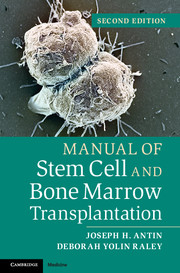Book contents
- Frontmatter
- Contents
- Acknowledgments
- Contributor
- 1 Rationale for transplantation
- 2 Types of transplantation
- 3 Human leukocyte antigen matching in allogeneic transplantation
- 4 Stem cell source
- 5 Pretransplant evaluation and counseling of patient and donor
- 6 Conditioning regimens
- 7 Stem cell infusion
- 8 ABO compatibility
- 9 Engraftment
- 10 Preventative care
- 11 Transplant-related complications
- 12 Overview of acute and chronic graft-versus-host disease
- 13 Acute graft-versus-host disease and staging
- 14 Graft-versus-host disease prophylactic regimens
- 15 Treatment guidelines for acute graft-versus-host disease
- 16 Chronic graft-versus-host disease
- 17 Engraftment syndrome
- 18 Infectious disease
- 19 Graft rejection and failure
- 20 Gastrointestinal complications
- 21 Oral health in stem cell transplantation
- 22 Pulmonary complications
- 23 Veno-occlusive disease
- 24 Special transfusion-related situations
- 25 Cardiovascular complications
- 26 Neurologic complications
- 27 Cystitis
- 28 Donor lymphocyte infusion
- 29 Transplantation: regulation and accreditation
- Index
- References
14 - Graft-versus-host disease prophylactic regimens
Published online by Cambridge University Press: 05 November 2013
- Frontmatter
- Contents
- Acknowledgments
- Contributor
- 1 Rationale for transplantation
- 2 Types of transplantation
- 3 Human leukocyte antigen matching in allogeneic transplantation
- 4 Stem cell source
- 5 Pretransplant evaluation and counseling of patient and donor
- 6 Conditioning regimens
- 7 Stem cell infusion
- 8 ABO compatibility
- 9 Engraftment
- 10 Preventative care
- 11 Transplant-related complications
- 12 Overview of acute and chronic graft-versus-host disease
- 13 Acute graft-versus-host disease and staging
- 14 Graft-versus-host disease prophylactic regimens
- 15 Treatment guidelines for acute graft-versus-host disease
- 16 Chronic graft-versus-host disease
- 17 Engraftment syndrome
- 18 Infectious disease
- 19 Graft rejection and failure
- 20 Gastrointestinal complications
- 21 Oral health in stem cell transplantation
- 22 Pulmonary complications
- 23 Veno-occlusive disease
- 24 Special transfusion-related situations
- 25 Cardiovascular complications
- 26 Neurologic complications
- 27 Cystitis
- 28 Donor lymphocyte infusion
- 29 Transplantation: regulation and accreditation
- Index
- References
Summary
Effective prophylaxis islimited by an incomplete understanding of the pathophysiology of thedisease. Drugs are often used in combination in an attempt to block severalpathways thought to cause graft-versus-host disease (GVHD). Use ofcalcineurin inhibitors in conjunction with methotrexate is the most commoncombination regimen. Institutions use a variety of combinations. The doseand toxicity of each agent are listed individually below.
Tacrolimus/methotrexate (MTX) or cyclosporine/MTX is superior to single-agent prophylaxis. When calcineurin inhibitors are used with lower doses of MTX, so-called “mini methotrexate” may attenuate mucositis caused by MTX.
Tacrolimus/mycophenolate mofetil (MMF) or cyclosporine/MMF are alternatives for patients who are unable to take MTX.
Sirolimus/tacrolimus/MTX or sirolimus/tacrolimus may allow for lower doses or the elimination of MTX, although there is an increased risk of veno-occlusive disease (VOD) if myeloablative conditioning is used.
Agents used for prophylaxis
Methotrexate
Mechanism of action
Blocks the enzymedihydrofolate reductase, which inhibits the conversion of folic acid totetrahydrofolic acid, resulting in inhibition of the key precursors of DNA,RNA, and cellular protein.
- Type
- Chapter
- Information
- Manual of Stem Cell and Bone Marrow Transplantation , pp. 53 - 63Publisher: Cambridge University PressPrint publication year: 2013

